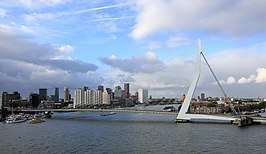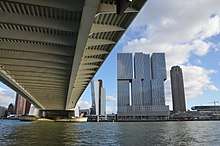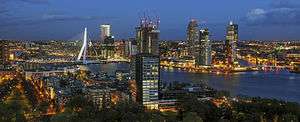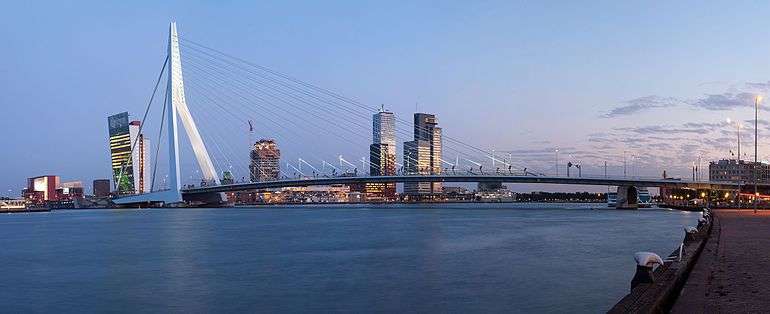Erasmusbrug
Erasmusbrug (English: "Erasmus Bridge") is a combined cable-stayed and bascule bridge completed in 1996 crossing the Nieuwe Maas in the centre of Rotterdam, connecting the north and south parts of this city, second largest in the Netherlands. The bridge was named in 1992 after Desiderius Erasmus, a prominent Christian Renaissance humanist also known as Erasmus of Rotterdam. The Erasmus Bridge is Rotterdam's most important landmark and is even part of the city's official logo.[4]
Erasmus Bridge Erasmusbrug | |
|---|---|
 The Erasmus Bridge in Rotterdam | |
| Coordinates | 51°54′33″N 4°29′12″E |
| Carries | 2 tramway tracks, 4 traffic lanes, 2 cycle tracks, 2 sidewalks |
| Crosses | Nieuwe Maas |
| Locale | Rotterdam, |
| Other name(s) | De Zwaan (The Swan) |
| Characteristics | |
| Material | Steel and concrete |
| Total length | 802-metre (2,631 ft)[1] |
| Width | 33.8-metre (111 ft) |
| Height | 139-metre (456 ft) |
| Longest span | 285-metre (935 ft) |
| No. of spans | 4 |
| Clearance below | 12.5-metre (41 ft) |
| History | |
| Designer | Ben van Berkel |
| Construction end | 1996 |
| Construction cost | € 165 million[2] (365 million Guilders)[3] |
 Erasmusbrug Location in Netherlands | |
History
The 802-metre-long (2,631 ft) bridge across the New Meuse was designed by Ben van Berkel and completed in 1996. The cable-stayed bridge section has a single 139-metre-high (456 ft) asymmetrical pale blue pylon with a prominent horizontal base, earning the bridge its nickname "The Swan".[1]
The southernmost span of the bridge has an 89-metre-long (292 ft) bascule bridge for ships that cannot pass under the bridge. The bascule bridge is the largest and heaviest in Western Europe and has the largest panel of its type in the world.
After costing more than 165 million Euros to construct, the bridge was officially opened by Queen Beatrix on September 6, 1996.[5] Shortly after the bridge opened to traffic in October 1996, it was discovered the bridge would swing under particularly strong wind conditions. To reduce the trembling, stronger shock dampers were installed.[6]
Design
.jpg)
During the preliminary design process, many alternative designs were developed. In 1990, one of the review architects, Ben van Berkel, revealed his own design, which was similar to the one Santiago Calatrava used for the Alamillo Bridge in Sevilla, Spain: a single pylon positioned on one side of the river with a backward lean. Because the initially designed 150-m-high concrete bent pylon was to act as a counterweight for the 284-m span, the pylon had no back stays.[1][7]
In the subsequent engineering feasibility study, a number of significant design changes were made. Most importantly, live loads, like 60-ton trucks, would introduce tremendous bending forces into the backward leaning pylon; therefore back stays were added to minimize bending forces. The 150-m-high concrete pylon was changed to a 139-m-high steel pylon. The overall appearance of the bridge design remained intact, however, which proved to be the decisive factor for its selection. In November 1991, the city council chose the highly ambitious backward leaning bent pylon shape and made available the necessary additional funds for the asymmetric bridge.[1][7]
The Erasmus Bridge is the result of an unusual design process in which architects and engineers interacted as equals. In the end this resulted in a bridge that evidences a full commitment to both technical and aesthetic standards.[7]

The thin deck profile was not only aesthetically motivated, but also dictated by a number of technical conditions, e.g., there needed to be a clear shipping height in the centre of the span of 12.5m for at least 200m. The deck was thus designed with two box girder spines, 2.25m high by 1.25m wide, where the cables were attached to support a deck with 4 traffic lanes and 2 tram tracks in between the two spines. The two spines were joined every 4.9m by transverse sections, which were cantilevered out 6.7m either side for the pedestrian and cycle ways.[8]
On the concrete piers, the engineers designed the steel tubes within the concrete piers to support the bridge and the architects designed the concrete form around these inner steel tubes as a sculptural form.[8]
Use in events
The bridge featured in the 1998 Jackie Chan film Who Am I?. In 2005, several planes flew underneath the bridge as part of the "Red Bull Air Race". The bridge is also part of The World Port Days in Rotterdam.
In 2005, the bridge served as the backdrop for a performance by DJ Tiësto titled "Tiësto @ The Bridge, Rotterdam". The performance featured fire-fighting ships spraying jets of water into the air in front of the bridge, a fireworks barge launching fireworks beside the bridge, and multi colored spot/search lights attached to the bridge itself.
The bridge was crossed during the prologue and the opening stage of the 2010 Tour de France It was also crossed during the second stage of the 2015 edition.
Gallery
 Erasmusbrug: cable-stayed and bascule bridge
Erasmusbrug: cable-stayed and bascule bridge- The bascule section raised, one set backstay in left foreground
 Detail of pylon from the bridge
Detail of pylon from the bridge- Rotterdam Erasmusbrug from above looking east
 Erasmus Bridge from the East
Erasmus Bridge from the East Erasmus Bridge at night seen from the Euromast in 2012
Erasmus Bridge at night seen from the Euromast in 2012
References
- Gannon, Todd, ed. (March 2004). UN Studio/ Erasmus Bridge, Rotterdam, The Netherlands (Source Books in Architecture (Book 4) ed.). Princeton Architectural Press. pp. 1–176. ISBN 156898426X.
- erasmusbrug
- cvspdfdocs
- "Erasmus Bridge: Holland's tallest bridge". cityguiderotterdam.com. Retrieved 15 May 2020.
- M de Jong, J Annema (2010). "The Erasmus Bridge; success factors according to those involved in the project". European Transport Conference. Archived from the original on 18 October 2012. Retrieved 7 November 2012.
- Geurts, Chris; Vrouwenvelder, Ton; van Staalduinen, Piet; Reusink, Jaco (February 1998). "Numerical Modelling of Rain-Wind-Induced Vibration: Erasmus Bridge, Rotterdam". Structural Engineering International. 8 (2): 129–135. doi:10.2749/101686698780489351.
Shortly after completion. the main span cables of the Erasmus Bridge in Rotterdam showed aerodynamic instabilities with large amplitudes. These instabilities were recognised as rain-wind-induced vibrations. Temporary measures were installed on the bridge, and a year later, tuned hydraulic dampers were mounted as a permanent solution.
- Reusink, Jaco; Kuijpers, Martin (November 1998). "Designing the Erasmus Bridge, Rotterdam". Structural Engineering International. 8 (4): 275–277. doi:10.2749/101686698780488794. Retrieved 15 May 2020.
The Erasmus Bridge is the result of an unusual design process in which architects and engineers interacted as equals. In the end this resulted in a bridge that evidences a full commitment to both technical and aesthetic standards.
- Hewett, Christopher J. (2008). "A Critical Analysis of the Erasmus Bridge" (PDF). bath.ac.uk. University of Bath. Retrieved 17 May 2020.
Abstract: The following paper gives information on the construction and design of the Erasmus Bridge, a critical analysis of the aesthetics and a consideration of the technical loading aspects to British standard codes.
External links
| Wikimedia Commons has media related to Erasmus bridge. |
- Erasmus Bridge at Structurae
- Erasmus bridge on bridge-info.org
- Erasmusbrug Youtube
- 2014 New Year Eve Firework from Erasmus Bridge (Video)
